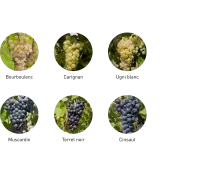Terroir and grape varieties
From diversity comes abundance
The Côtes du Rhône wines are made across a swirling mosaic of different terroirs. They reflect the varying landscapes, geological make up and climate of the region as well as its grapes, vineyard management practices and favourite winemaking techniques, but there’s still a sense of unity, a ‘Côtes du Rhôneness’ about them. There’s a clear pattern, on several levels. We can start by dividing the appellation into 2 zones, north and south.
In total, 27 grape varieties are cultivated in the appellation, including Syrah, Viognier, Marsanne and Roussanne, which are native to the region.

Terroirs of extreme diversity
It all comes down to the region’s rather turbulent geological past, which has left it with a variety of different landscapes. At its start between the Massif Central and the Alps, the Rhône Valley is relatively narrow, broadening out as we move south towards Montélimar and beyond. The landscape is a mix of sheer slopes, hills and plains, all framed by the rugged peaks of distant mountains.
The Massif Central first of all; these are mainly granite and other rock dating back over 300 million years to the Primary geological period. Meanwhile the left bank, to the east of the river, is part of the Alpine foothills and features gentler slopes and rolling hillsides.
Much of the landscape has been shaped by erosion, giving the Côtes du Rhône its distinctive peaks and slopes. Also, over the years, the river has deposited alluvium in places, and chunks of rock known as pudding stones (the famous galets roulés) most often seen in the southern part of the appellation.
The richness of the terroirs of the northern Côtes du Rhône
In the northern part, the vineyards hug the riverbanks, and the climate is continental (hot summers and cold winters). The vines grow on steep slopes carved from the rocks of the Massif Central mountains.
The northern part of the Rhône Valley consists almost entirely of sloping ground, from Lyon all the way down to Valence. Vineyards cling to steep, narrow terraces – some no more than a couple of metres wide – supported by low stone walls. It takes a lot of ingenuity and sheer hard work to grow just a few acres of vines.
The terraces have been around since Gallo-Roman times, possibly built by Roman legionaries stationed near the town of Vienne. And they’ve proved over and over again that it was worth the trouble.
It must have been back-breaking work and needed a lot of technical skill, and even once the terraces were built, the work wasn’t over – tending the vines was just as laborious. Even now, all vineyard work is done by hand, including pruning, weeding and harvesting, and coaxing the vines into giving us high yields can be hard work. But those legionaries knew what they were doing, as the advantages far outweigh the hardships. On the terraces, the sun hits the soil at right angles for maximum energy, while the stone walls absorb heat by day, releasing it back to the vines at night to boost ripening, giving exciting, top-quality wines.
The richness of the terroirs of the southern Côtes du Rhône
The southern zone is mellower, more Mediterranean in character. And we can further subdivide this into 3 distinct terroir types:
Limestone soils; vines in this type of soil are relatively unusual in the southern Côtes du Rhône. They’re seen primarily in the Dentelles de Montmirail, for example, cheek by jowl with the craggy, soaring mountains. Limestone terroirs give wines elegance and precision, and are great for whites.
Sandy soils are a feature of the stone-covered hillsides, and are planted with Grenache and Syrah to give light, fruity wines.
Free-draining terraces of smooth, rounded pudding-stones where Grenache is blended with Syrah and Mourvèdre give smooth, velvety wines with plenty of ripe fruit and a touch of spice. White wines are rich and elegant.
The Côtes du Rhône wines hierarchy – a pyramid with the Côtes du Rhône regional appellation at its base and Côtes du Rhône Villages (with or without village name) on the level above – makes detailed distinctions between specific types of terroir, and helps you make your choice.
Côtes du Rhônes wines
Key figures
The Côtes du Rhône appellation area is spread over 172 communes in six departments in the south of the wine region: Ardèche, Drôme, Gard, Loire, Rhône and Vaucluse.
Grape varieties
27
The blend of AOC Côtes du Rhône wines is based on a palette of 27 grape varieties.
Soil
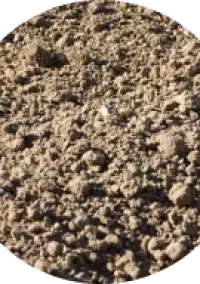
Sands
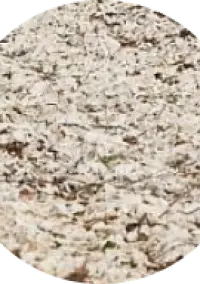
Calcaire
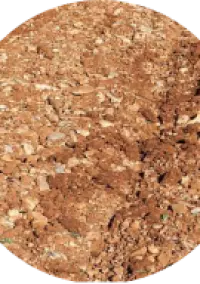
Clay
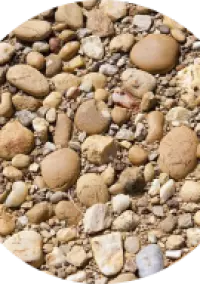
Rocky
Climate
Mediterranean
Influenced by Mistral wind
Landforms
North
The northern Côtes du Rhône are mainly planted on hillsides on the left and right banks of the Rhône.
South
To the south, the landscapes are much more varied between hills, steep terrain, alluvial plains, plateaus and terraces.
Sunshine
≈ 2,300 h/year
Clearly the weather, particularly the sun, affects the speed at which grapes ripen. As we travel from the north of the valley down towards the Mediterranean, the average number of sunshine hours per year gradually increases. The area just south of Lyon has between 1,900 and 2,100 hours of sunshine each year, rising to between 2,200 and 2,300 towards the middle of the valley around Valence, and reaching an impressive 2,800 plus hours of sunshine around Avignon.
The average annual level of sunshine in the Côtes du Rhône is among the highest in France. Given the differences in climate, harvests are generally earlier in the south than the north, and the wines lean more towards a warm-climate style – smooth and rich with ripe fruit flavours and less acidity.
Altitude
Up to 600m
The Côtes du Rhône vineyards are to be found in a mosaic of landscapes, from the Rhone Valley to the steepest slopes. It flourishes in a variety of terroirs, sometimes perched at altitudes of up to 600 metres, as in the foothills of the Massif Central or in the Baronnies provençales, around Nyons.
Production

Red: 90%

Rosé: 5%
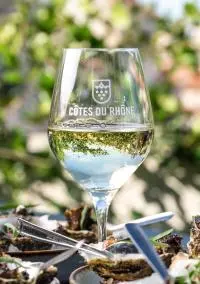
White: 5%
Total production
1,222,142 HL
Focus on grape varieties
The main grape varieties
The wines of the Côtes du Rhône and Côtes du Rhône Villages appellations are blended wines par excellence. Of the three main grape varieties used for Côtes du Rhône wines (Syrah, Grenache and Mourvèdre), Syrah dominates in the north of the valley where it originates, while Grenache and Mourvèdre, both of Spanish origin, are more prevalent in the south.
The combination of these three grape varieties, which make up the DNA of Côtes du Rhône, produces wines that are structured, aromatic and suitable for ageing.
Iconic main grape variety
Syrah
The dominant grape variety in the Rhône Valley, it is the only red grape variety used in Côtes du Rhône Crus wines. It is one of the most widely grown grape varieties in the world and has inspired some of the most renowned winemakers in the New World.
A bit of history
Syrah has such mysterious origins that French and American researchers have studied its DNA to prove that it is the result of a natural cross between a grape variety from the Ardèche region and one from Savoie. Legend has it that the Chevalier de Sterimberg, after crossing swords with the Albigensians, retired to the hillsides of Tain-l'Hermitage to cultivate it.
Aromas
Syrah is the emblematic grape variety of the northern Côtes du Rhône.
This grape variety predominates in the northern Côtes du Rhône on granite soils, where it imparts spicy aromas of blackcurrant, blueberry, violet and blackberry to the wines; and as it ages, secondary aromas of leather and fur.
In addition, it has an ageing potential that ranks it among the greatest French wines.
In the Côtes du Rhône, Syrah is most often accompanied by other grape varieties such as Grenache and Mourvèdre.
Main grape variety
Grenache
Suitable for hot summers and dry conditions, Grenache requires deep, chalky soils. This grape variety dominates the southern half of the Côtes du Rhône region.
A bit of history
Like Mourvèdre, Grenache originated in Spain and migrated during the Middle Ages, probably via pilgrims returning from Santiago de Compostela.
Aromas
Grenache gives Côtes du Rhône wines many flavourful qualities.
On the palate, we find aromas of blackcurrant and blackberry. These complex, rich, fruity aromas in its youth, with great breadth on the palate, become more spicy after ageing.
Main grape variety
Mourvèdre
Like Grenache, Mourvèdre is well suited to the intense heat of the southern Rhône Valley.
It is also sometimes preferred to Syrah by winegrowers in the Mediterranean region, as it can ripen perfectly in exceptionally hot summers.
A bit of history
Mourvèdre, also of Spanish origin, appeared in the Côtes du Rhône region in the Middle Ages. This grape variety comes from the Valencia region.
Aromas
Mourvèdre produces colourful, full-bodied and structured wines with great ageing potential.
We find aromas of pepper and black fruits (blackcurrant, blackberry) with vegetal notes of garrigue and bay leaf when the wines are young. As they age, we find more complex aromas of truffle, undergrowth, leather and jammy fruit, as well as beautiful hints of game and spices.
Complementary grape varieties
The others – known as complementary varietals – include Bourboulenc, Carignan, Cinsault, Muscardin, Terret Noir and Ugni Blanc, and are added to blends in much smaller quantities to give the desired effect. Some (Muscardin, Roussanne and Marsanne) are native to the Rhône Valley, others come from Spain (Carignan) or Italy (Ugni Blanc).
They help to soften the main varietals, adding a tang of acidity here, brightening the flavour there…
Among these grape varieties, Carignan is a prime example. Carignan was probably originally from Spain, and has taken quite a while to acclimatise. We almost gave up on it a while ago, but thank goodness we didn’t. It gives mouthwatering flavours of raspberries, cherries and blackberries, with a comforting undertow of leather, violets and even garrigue herbs.
